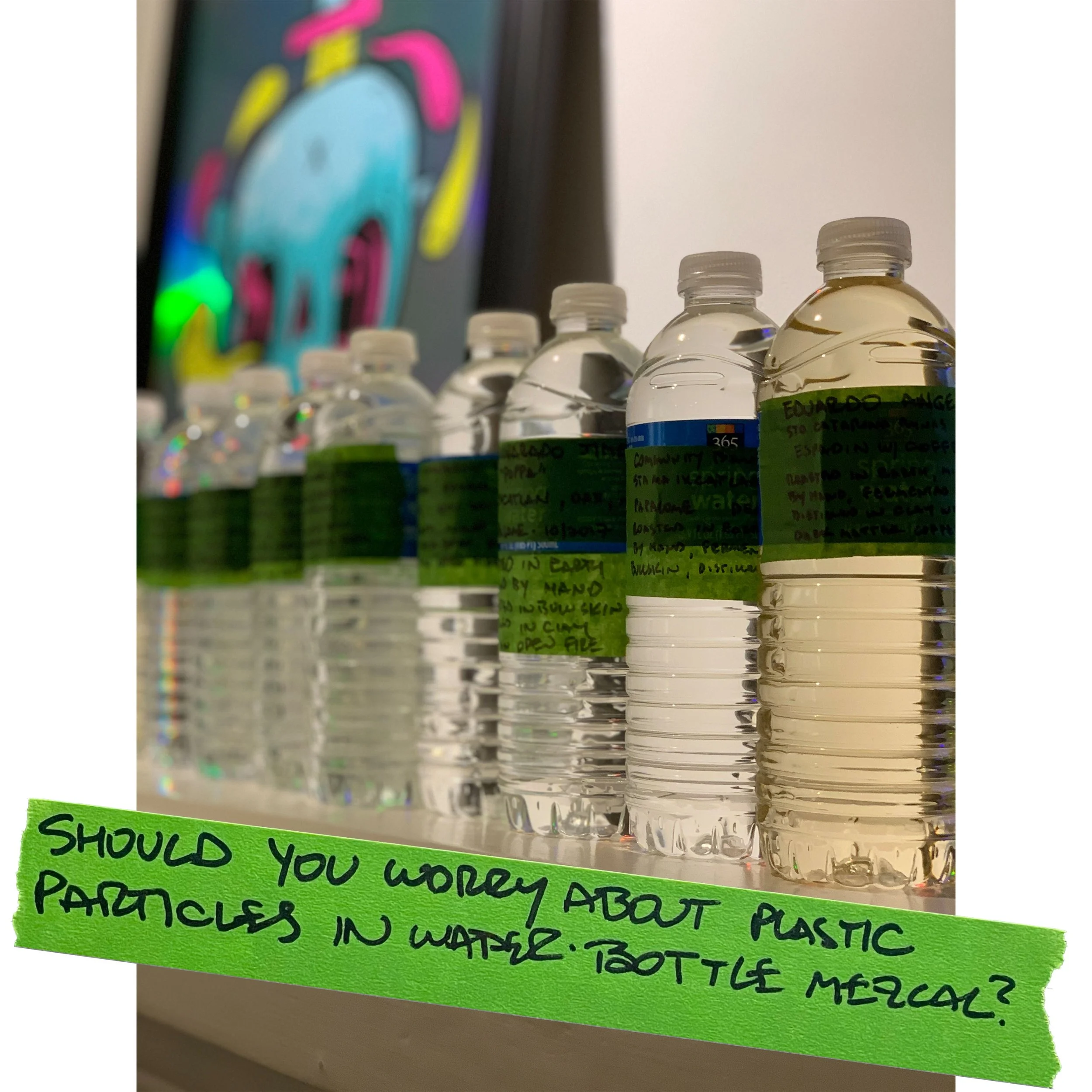Should you worry about plastic in your water-bottle mezcal?
The best stuff is always in plastic water bottles — that’s a thing I hear from a lot of Mezcal geeks. But lately I’ve been reading a lot of stories in the news about how most of us have plastic in our blood stream. And that’s got me wondering … is the stuff brought back from Mexico in plastic water bottles really the best stuff, then? Or am I just drinking myself to death in an unexpected way? Agave Road Trip’s Chief Medical Correspondent Dr. Ryan Aycock plastic-coats this episode of Agave Road Trip!
Agave Road Trip is a critically acclaimed, award-winning podcast that helps gringx bartenders better understand agave, agave spirits, and rural Mexico. This episode is hosted by Lou Bank with Agave Road Trip Chief Medical Correspondent, Dr. Ryan Aycock.
Episode Notes
Check out Simply Cocktails by Dr. Ryan Aycock, the Cocktail MD!
This is the story that sparked the episode: “Microplastics found in human blood for first time,” The Guardian, March 24, 2022
And here are Dr. Aycock’s crazy-detailed notes for this episode:
Plastic water bottles are primarily made of polyethylene terephthalate, polycarbonate, and polyethylene, in that order, according to the International Bottled Water Association statement.
Bisphenol A is an industrial chemical used to make polycarbonate. The Food and Drug Administration states that BPA “is safe at the current levels occurring in foods.” BPA is everywhere: the lining of soup cans, thermal paper used in receipts that you receive after making a purchase in a store, and sometimes in socks.
So, is BPA dangerous? In short, when bisphenol A is given directly to mouse and cow oocytes (single egg cells found in the ovary), there are problems with meiosis and chromosomal abnormalities. But these are in-vitro studies involving oocytes from mice and cows. What have we seen from humans?
Here’s a cross-sectional study: BPA levels are higher in women with PCOS. Another cross-sectional study found higher BPA levels correlate positively with higher testosterone levels in women with PCOS. Therefore, BPA is sometimes called an endocrine disruptor.
In another cross-sectional study, they found decreased rates of in-vitro fertilization in 26 women who had higher levels of serum BPA. They found no association between BPA and oocyte maturation when all cases were considered. But … Doc has a real problem with this paper as it was a research letter, and as such, did not undergo peer review. Further, the authors divided patients by race and age to try to come up with any kind of statistically significant differences between groups. Once we get down to the level of talking about five or six people and comparing them to another five or six people, Doc says we really aren’t looking at statistical significance.
More studies:
The in-vitro fertilization clinic at Brigham and Women's Hospital randomized 352 discarded oocytes (eggs) to base in BPA or a placebo. Researchers noted that the experimental group showed problems with cell division.
The InCHIANTI study was a population-based study on aging that was conducted in Chianti, Italy, from September 1998 to March 2000. Higher daily BPA excretion was weakly associated with higher total testosterone concentrations in men. They found no associations between BPA and estrogen or testosterone levels among women.
Researchers from China followed 121 diabetics over six years and watched their kidney function change over time. What they found is that persons with higher serum BPA levels had worse kidney function at the end of six years. (Doc has a problem with this study, too: The frequency of BPA measurements is never mentioned. We do not know if BPA was measured at the beginning of the study, the end of the study, or at multiple points in between. Given that diabetes is already a risk factor for kidney disease, and that these patients were taking multiple medications and had other diseases such as high blood pressure, we do not know what kind of confounders could have contributed to kidney injury. Also, BPA is eliminated by the body through the kidneys. If a person develops kidney disease, you’d expect their serum BPA levels would be higher as a function of impaired kidneys, and not the other way around.)
Researchers followed 262 mother-child pairs starting at 16 weeks gestation and ending at the age of three. The mothers had urinary BPA levels measured at 16 weeks, 24 weeks, and within 24 hours of birth. The children had the same measurements performed at one, two, and three years of age. The mothers, who were unaware of the measurement results, completed questionnaires regarding their children’s behavior, measuring in multiple domains such as hyperactivity, anxiety, and depression. The only correlations the researchers could find was that higher BPA concentrations from the mother’s were associated with depression, anxiety, and hyperactivity among girls. They found no correlation using children’s BPA levels, nor were there any correlations between mothers’ BPA levels and boys, except that hyperactivity actually decreased.
As a result of these kinds of studies, multiple countries have banned BPA in children’s products such as pacifiers and bottles.
So … how does bisphenol A actually work on humans?
Consuming soy milk from a can lead to higher urinary BPA levels when compared to consuming soy milk from a glass bottle.
Bisphenol A was given to six healthy subjects who had blood and urine measured afterward. BPA appears to be metabolized by the kidneys and is rapidly and fully excreted from the body within hours. BPA does not undergo first-pass metabolism through the liver, as it does in mice.
From a cross-sectional study, written as a letter to the editor: Researchers recruited 292 inner-city children at Harlem Hospital and New York Presbyterian Hospital and found that higher levels of BPA in the urine of young children was somewhat correlated with an increased diagnosis of childhood asthma.
BPA levels are higher in diabetics than nondiabetics.
BPA leaches out of plastic water bottles at higher temperatures, which is why you’ll sometimes hear people give advice such as avoiding keeping water bottles in your car.
There is really no clinical data on alcohol + plastic bottles, but BPA is in canned beverages such as beer.
https://www.sciencedirect.com/science/article/pii/S0048969723013335
Researchers shined ultraviolet light on polyethylene and polyethylene terephthalate. Microplastic particles were exposed to sunlight for 30 days in advance of UV treatments. The plastics were then exposed to UV-A and UV-C light, resulting in the release of more than 50 volatile organic compounds that have names like Hexadecane. Doc went through the list of organic compounds and tried to find any clinical research on potential toxic effects. In short, he found none. Hexadecane is a known skin irritant, but that is it. A family of compounds called phthalates can be found in the urine of pregnant women, but the clinical significance is unknown.
So what can you do to avoid polycarbonate and PET? Well, first, Doc says you should first avoid YouTube quacks who say that we cannot eat food that is in plastic wrap. But his big take-home point: your agave spirits are probably safe in a plastic bottle. By the way, just because something is labeled BPA- free, does not mean that there are not other bisphenols.
Look for the recycling symbols with 2 or 4 (polyethylene) or 5 (polypropylene), both of which are considered safe in humans. And for the record, Ciel, Bonafont, and Vitawa all are labeled either 7 or 1. Type is too small for me to read. And Doc says maybe avoid 7.

